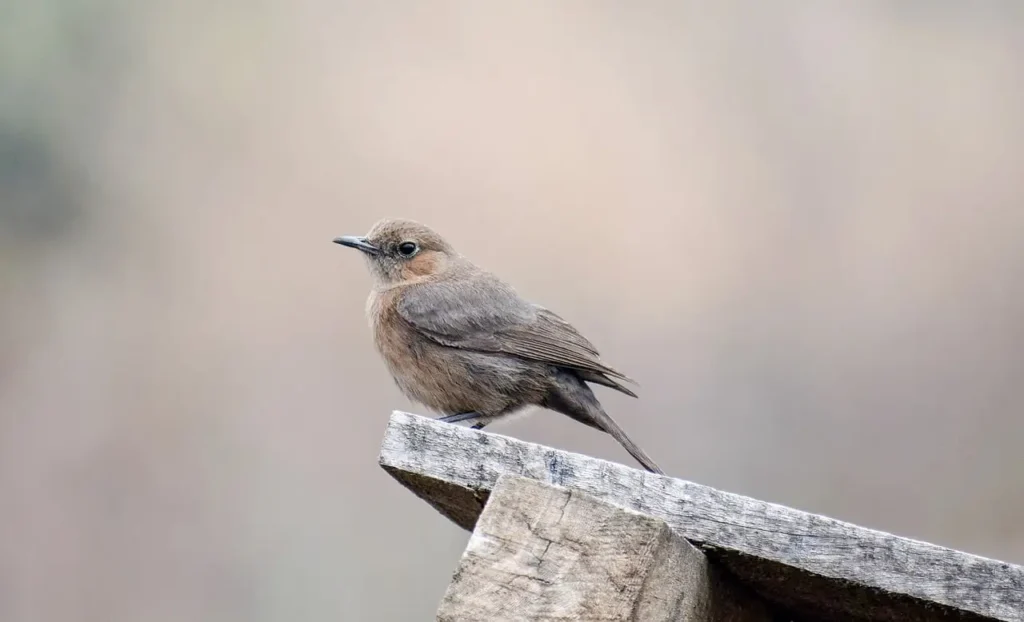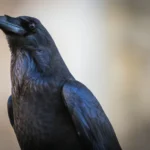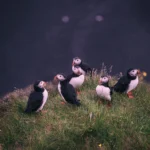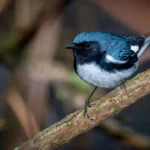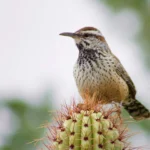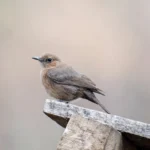Florida is a birdwatcher’s paradise, offering everything from majestic egrets to flashy warblers. But tucked away in our shrubs, marshes, and backyards are some of the most charming and underappreciated avian residents—small brown birds. Often dismissed as “just another sparrow,” these subtle species bring personality, song, and ecological importance to the landscapes they inhabit. In this guide, we’ll explore 10 commonly found small brown birds in Florida, focusing on how to identify them, where to find them, and why they matter.
Also read: 14 Shorebirds of Florida and How to Identify Them
10 Types of SmalL Brown Birds In Florida
1. Carolina Wren (Thryothorus ludovicianus)
Appearance and Identification
The Carolina Wren is a compact, energetic bird with rich, reddish-brown plumage on its back and buff-coloured underparts. One of its most distinctive features is a bold white eyebrow stripe that runs from the beak to the back of the head. It has a long, slightly curved bill and often holds its tail cocked upward. Measuring around 5.5 inches in length, this small bird is commonly mistaken for other wrens but stands out due to its vibrant colour and loud voice.
Habitat and Range in Florida
Found throughout Florida year-round, the Carolina Wren is incredibly adaptable. It thrives in wooded backyards, suburban gardens, forest edges, overgrown lots, and even urban parks. You’ll often spot them hopping among palmetto leaves, vines, or low branches as they search for insects. Their ability to nest close to human homes makes them one of the most commonly seen small brown birds in the state.
Diet and Foraging Behaviour
Carolina Wrens are primarily insectivorous, feeding on beetles, caterpillars, spiders, and other small invertebrates. They forage actively by probing leaf litter, fallen logs, or tree bark, often using their curved bill to dig out hidden prey. In winter or during food shortages, they may also eat seeds, berries, and suet from backyard feeders.
Vocalisations and Song
This tiny bird has a voice that’s far larger than its body. The male Carolina Wren is known for its clear, whistled phrases, often described as “teakettle-teakettle-teakettle.” These repeated calls can be heard year-round and help establish territory. Wrens are also known to mimic the songs of other birds, making them quite the vocal performers in Florida’s morning chorus.
Nesting and Breeding Habits
Carolina Wrens are creative nesters. They build cup-shaped nests in cavities or sheltered spots, including hanging flower pots, mailboxes, garage shelves, and even old boots. The nesting season in Florida typically begins as early as March and may continue through summer, with the potential for multiple broods per year. A typical clutch contains 4 to 6 eggs, which are creamy-white with reddish-brown speckles.
Behaviour and Personality
These wrens are curious, active, and fiercely territorial. They’ll often investigate open sheds, porches, or garages in search of nesting spots. Despite their small size, they boldly defend their territory with loud calls and aggressive posturing toward intruders. Their energetic hopping and tail-flicking make them fun to watch, especially when they dart from shrub to shrub.
Conservation and Interesting Facts
The Carolina Wren population in Florida is stable and widespread. Their adaptability to human environments has helped them thrive even in suburban and urban settings. A few interesting facts: they mate for life, both partners help raise the young, and they often return to the same nesting site each season. If you hear loud singing from a hidden corner of your yard, there’s a good chance it’s this charming little wren announcing its presence.
Also read: Types of Florida Woodpeckers with Pictures
2. House Wren (Troglodytes aedon)
Appearance and Identification
The House Wren is a small, drab bird with a warm brown back, slightly paler underparts, and faint barring on the wings and tail. It has a short, slightly curved bill and a flat head profile. Though it lacks bold markings, its small, rounded body and constantly flicking tail give it an energetic appearance. At around 4.75 inches long, the House Wren is often overlooked due to its plain colouring, but its quick movements and persistent chatter make it noticeable if you pay close attention.
Habitat and Range in Florida
House Wrens are winter residents in Florida, typically arriving in the fall and departing by spring. During this time, they inhabit a wide variety of habitats, including backyards, parks, overgrown fields, and forest edges. They prefer areas with dense underbrush or piles of brush where they can forage and find cover. Although they don’t usually breed in Florida, they may investigate cavities and nest boxes out of curiosity.
Diet and Foraging Behaviour
Insects and spiders make up the bulk of a House Wren’s diet. They actively forage close to the ground, hopping and climbing through vegetation, dead logs, and brush piles. They’re known for their meticulous searching—turning leaves, pecking into crevices, and even exploring small holes and nooks. During colder months, when insect activity slows, they may occasionally consume seeds or small berries, but they primarily rely on protein-rich prey.
Vocalisations and Song
The House Wren’s voice is louder and more complex than one might expect from such a small bird. Its song is a rapid, bubbling series of trills and chatters, often delivered from a low perch or while actively foraging. The male sings frequently, even during winter, to establish territory or communicate with other wrens. Their call is a sharp, dry “churr” or “chek” sound, often given in alarm when disturbed.
Nesting and Breeding Habits
House Wrens are not regular breeders in Florida, as their main breeding range is farther north. However, during migration, they sometimes inspect potential nesting sites like nest boxes or natural cavities. In their breeding range, they are notorious for their competitive nature—females line their nests with soft material, while males may build multiple nests to entice a mate. They may also remove or puncture the eggs of other cavity-nesting birds.
Behaviour and Personality
These tiny wrens are bold, inquisitive, and full of energy. Despite their small size, they often dominate backyard scenes with their vocal presence and persistent movement. They’re fearless explorers, often entering garages, sheds, or patios in search of food or nesting spots. During the winter months, they can be seen solo or loosely associating with other small birds in mixed flocks.
Conservation and Interesting Facts
House Wren populations remain strong, thanks to their adaptability and preference for human-altered landscapes. They readily use birdhouses and tolerate proximity to people. One fascinating trait is their intense nest competition—House Wrens often sabotage the nests of other species to secure prime spots. Though they’re seasonal visitors to Florida, their sprightly nature makes them a welcome wintertime sight.
3. Brown Thrasher (Toxostoma rufum)
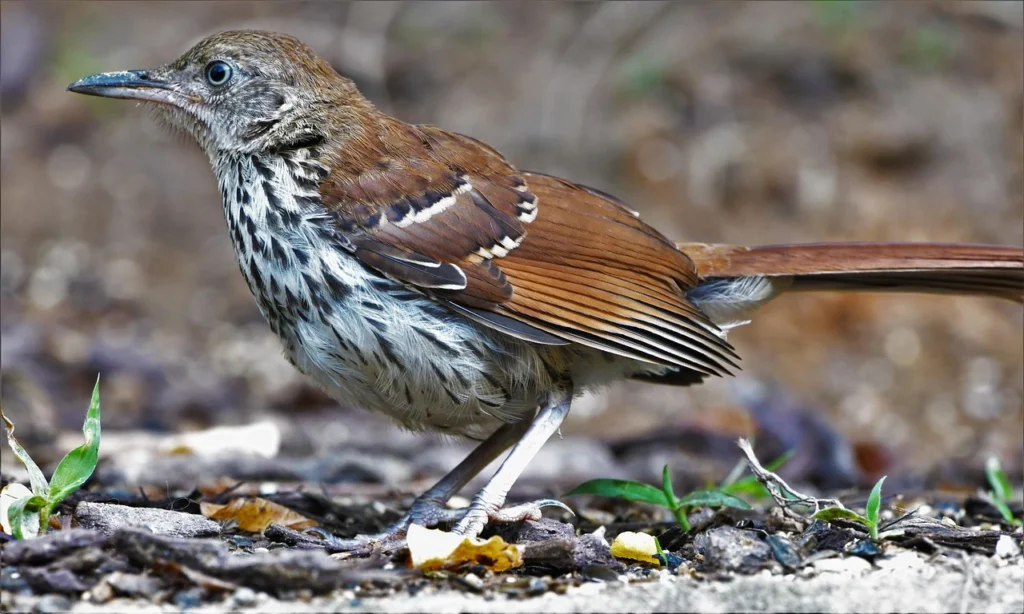
Appearance and Identification
The Brown Thrasher is a large, slender songbird with rich, reddish-brown plumage above and boldly streaked white underparts. It features a long, slightly curved bill and an elongated tail that it often flicks or fans. Its bright yellow eyes give it a piercing, alert look, and the wings display two faint white wing bars. Measuring about 11 inches in length, the Brown Thrasher is larger than most backyard birds and is sometimes mistaken for a small hawk or a juvenile thrush at a glance. However, its elongated form, heavy streaking, and deep rufous back are distinguishing features.
Habitat and Range in Florida
In Florida, the Brown Thrasher is a year-round resident, found throughout the state in a variety of semi-open habitats. It favours dense thickets, shrubby hedgerows, woodland edges, and overgrown fields. These birds prefer environments where they can remain partly hidden while foraging or nesting. While they are not often seen in open spaces, you can sometimes spot them darting across trails or perching briefly on low fences before vanishing into underbrush. They are also common in suburban yards with dense shrubbery and fruiting plants.
Diet and Foraging Behaviour
Brown Thrashers have an omnivorous diet, consuming a wide variety of foods including insects, earthworms, snails, fruits, seeds, and occasionally small lizards or frogs. They forage primarily on the ground, using their strong bills to flip leaves, scratch soil, and dig into mulch to uncover hidden prey. Their feeding style is vigorous and deliberate—often tossing aside debris with such force that it draws attention. In fall and winter, berries from native plants like holly, wax myrtle, and beautyberry form a significant part of their diet.
Vocalisations and Song
The Brown Thrasher is one of Florida’s most impressive songsters. Its song is a lengthy, melodious series of phrases, each usually repeated twice before moving on to a new one. It’s known to mimic other birds and even mechanical sounds, much like a mockingbird. Males sing from prominent perches, especially during the spring breeding season. Their calls include a sharp, metallic “chak” or “tchuck,” often heard when the bird is startled or when it feels its nest is threatened.
Nesting and Breeding Habits
Nesting begins early in spring and can extend into late summer. Brown Thrashers build bulky cup-shaped nests made of twigs, vines, and grass, typically placed low in dense shrubs, thorny bushes, or tangled vines. The female lays 3 to 5 bluish-white eggs speckled with brown, which are incubated by both parents for about 12 to 14 days. After hatching, the chicks remain in the nest for about 9 to 13 days before fledging. Both parents are highly protective and may dive at intruders that come too close to the nest.
Behaviour and Personality
Although they are secretive by nature, Brown Thrashers are fiercely territorial and can be quite bold when defending their space. They are usually solitary or found in pairs and spend much of their time hidden in brush. When seen, they move with confidence, walking or hopping rather than flying short distances. Their bright eyes, alert posture, and powerful digging actions give them an air of purpose. They rarely visit feeders, preferring natural food sources, but may be attracted by mealworms or dense shrubbery.
Conservation and Interesting Facts
The Brown Thrasher’s population is generally stable, but local declines have been noted in areas where hedgerows and dense cover have been removed due to suburban development. As the state bird of Georgia, it holds cultural significance in the southeastern U.S. It’s also the only thrasher species that regularly breeds east of the Mississippi River. Its vocal repertoire is thought to include over 1,000 different song phrases—one of the largest among North American songbirds—making it a remarkable subject for birders and naturalists alike.
Appearance and Identification
The Brown Thrasher is Florida’s only regularly occurring thrasher. It’s larger than most wrens and sparrows, but still fits the “small brown bird” category due to its slim build. It has rich rufous upperparts, a long tail, and heavily streaked white underparts.
4. Eastern Phoebe (Sayornis phoebe)
Appearance and Identification
The Eastern Phoebe is a small, slender flycatcher with a plain yet charming appearance. Its upperparts are a soft brownish-gray, while its underparts are off-white to pale yellowish, often with a dusky wash on the chest. It has a short, dark bill and a subtle, rounded head crest that gives it a domed-headed profile. One of the bird’s most notable habits is tail-wagging—it constantly bobs its tail while perched. Measuring around 6.5 inches in length, the Eastern Phoebe lacks strong field marks but can be easily identified by its posture, quiet demeanor, and behaviour.
Habitat and Range in Florida
In Florida, the Eastern Phoebe is primarily a winter resident, although small breeding populations may occur in the Panhandle and North Florida. It inhabits open woodlands, forest edges, pastures, stream banks, and residential areas—often staying near water. This species has adapted well to human presence and is frequently seen perching on fences, low branches, utility lines, and under eaves or porch roofs. During cooler months, they become widespread across the state, often returning to the same wintering site year after year.
Diet and Foraging Behaviour
Eastern Phoebes are insectivorous, relying heavily on flying insects such as flies, wasps, beetles, and dragonflies. They hunt using a “sit-and-wait” technique—perching on a low branch or wire, then darting out quickly to catch prey in mid-air before returning to the same perch. This flycatching behaviour is efficient and energy-conserving. In winter, when insect availability is lower, they diversify their diet with small fruits and berries, including those from poison ivy, sumac, and dogwood plants. They may also occasionally snatch insects from the ground or foliage.
Vocalisations and Song
The Eastern Phoebe’s call is a sharp, quick “chip” or “tsip,” used for alerting others or expressing mild alarm. Its song is a simple, raspy two-syllable “fee-bee,” from which it gets its name. The song is not melodic but is distinctive and often one of the earliest bird songs heard in late winter and early spring. Males sing persistently during the breeding season to attract mates and defend territory. Though quieter in Florida’s winter range, individuals may still call during warm spells or in response to sunlight and warmth.
Nesting and Breeding Habits
In their northern breeding range—and occasionally in North Florida—Eastern Phoebes nest in sheltered, human-made or natural ledges. Typical nest sites include building eaves, barn rafters, under bridges, or rocky outcrops. The female constructs a cup-shaped nest from mud, moss, and grass, usually on a horizontal surface protected from the elements. She lays 3 to 6 white eggs, sometimes with faint speckles. Incubation lasts about 15–16 days, and the young fledge within 16–18 days. Pairs may raise two broods per season, often reusing or refurbishing the same nest site.
Behaviour and Personality
Eastern Phoebes are calm, unaggressive, and solitary in nature. Unlike other flycatchers, they do not join mixed flocks and prefer to forage alone. They’re often unbothered by human activity and can become quite tame around homes and buildings. Their quiet confidence, habit of returning to the same perch, and tail-wagging behaviour make them easy to recognise for attentive birders. While not flashy, their reliability and soft personality have made them favourites among naturalists and homeowners alike.
Conservation and Interesting Facts
Eastern Phoebes have adapted remarkably well to human-altered landscapes and are not currently of conservation concern. Their population is stable and widespread. They were the first North American bird species to be banded by John James Audubon in the early 1800s, marking a milestone in ornithology. Their readiness to nest near buildings makes them one of the most accessible and observable flycatchers for beginning birders and families interested in wildlife.
5. Song Sparrow (Melospiza melodia)
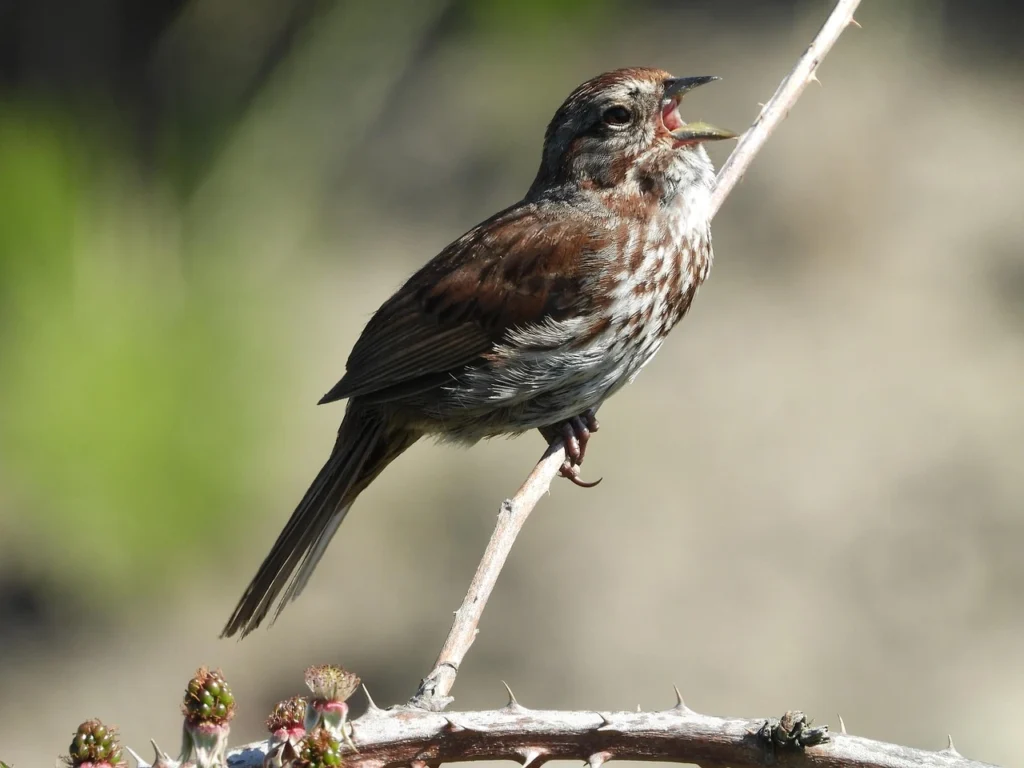
Appearance and Identification
The Song Sparrow is a medium-sized sparrow with a rounded head, streaked brown and gray upperparts, and heavily streaked underparts that often form a central dark spot on the breast. Its face features a greyish cheek patch, bordered by a warm brown stripe through the eye and a lighter eyebrow. The long, rounded tail is frequently flicked and fanned. At approximately 6 inches long, the Song Sparrow is slightly chunkier than other common sparrows, with a sturdy build and robust bill. Its pattern can vary regionally, but in Florida, wintering birds usually exhibit rich brown streaks and bold facial markings.
Habitat and Range in Florida
In Florida, the Song Sparrow is a winter visitor, arriving from northern breeding grounds in late fall and remaining through early spring. During this period, they occupy brushy fields, wet meadows, marsh edges, hedgerows, and shrubby roadsides. They are frequently found in semi-open habitats that offer dense low cover for foraging and protection. Song Sparrows are quite adaptable and may also be seen in gardens, overgrown lots, and park margins, especially near water sources.
Diet and Foraging Behaviour
Song Sparrows are ground foragers, feeding on a mix of seeds and insects. In Florida’s winter landscape, they primarily eat the seeds of grasses, weeds, and herbaceous plants. When insects are available, particularly during warmer periods, they’ll catch beetles, caterpillars, ants, and spiders. They forage by hopping and scratching at the leaf litter or probing along the base of vegetation, typically staying low and moving in short bursts. While they seldom visit feeders, they may occasionally eat millet or cracked corn scattered on the ground.
Vocalisations and Song
The Song Sparrow’s name is well-earned—its song is one of the most beautiful and recognisable among sparrows. It typically starts with two or three clear, whistled notes followed by a cheerful mix of trills, buzzes, and warbles. Males sing to attract mates and mark territory, and though less frequent in winter, singing can still be heard on sunny days in Florida. Their call note is a sharp “chimp” or “tchlep,” often used for communication or a mild alarm. Each male has a unique song pattern, adding variety to their habitats’ soundscape.
Nesting and Breeding Habits
Song Sparrows do not breed in most parts of Florida, but in their breeding range, females build cup-shaped nests made from grasses, bark strips, and rootlets. Nests are typically placed low in shrubs, dense vegetation, or even on the ground, hidden from predators. The female lays 3 to 5 eggs, which she incubates for 12–14 days. Both parents help feed the young, which fledge about 10–12 days after hatching. Song Sparrows often raise two to three broods in a single season in northern habitats.
Behaviour and Personality
These sparrows are alert and active, often flicking their tails and hopping through brushy cover with energy. Although cautious, they are not overly shy and may feed in view if approached slowly. In winter, they can be seen singly or in small flocks and may join mixed-species groups. Their behavior is observant and responsive—they often respond quickly to new noises or movement in their vicinity. With patience, birders can enjoy extended views of their foraging and even vocal interactions.
Conservation and Interesting Facts
The Song Sparrow is one of the most widespread and regionally variable sparrows in North America, with over 20 recognised subspecies. Their adaptability to different environments, from coastal marshes to high mountain meadows, contributes to their stable population status. Interestingly, Song Sparrows adjust the complexity of their songs depending on population density—more complex in competitive areas. Their beautiful and individualised songs make them a delight for birders and an ideal species for studying bird communication.
6. Swamp Sparrow (Melospiza georgiana)
Appearance and Identification
The Swamp Sparrow is a compact, subtly attractive sparrow with a warm rufous crown, gray face, and dark streaked back. Its wings often show chestnut tones, and the underparts are a smooth, buffy gray without the bold streaking seen in the Song Sparrow. The throat and chest are clear, and the flanks may show faint washes of color. This species also has a relatively long, rounded tail and a stout bill, sometimes appearing slightly yellowish at the base. At around 5.5 inches long, the Swamp Sparrow blends in beautifully with its wetland surroundings, making it a bit tricky to spot despite its frequent presence.
Habitat and Range in Florida
In Florida, the Swamp Sparrow is primarily a winter visitor, arriving in late autumn and departing by early spring. It thrives in freshwater and brackish marshes, wet prairies, grassy ditches, and low-lying fields with standing water and dense vegetation. These birds prefer habitats with tall grasses, sedges, or reeds, where they can forage while remaining well-concealed. Birders can find them in wildlife refuges, coastal wetlands, and wet agricultural margins, particularly early in the morning when the birds are most active.
Diet and Foraging Behaviour
Swamp Sparrows feed on a mix of seeds and invertebrates. During the winter months in Florida, their diet leans heavily toward grass seeds and aquatic plant matter, though they still consume spiders, beetles, and other small insects when available. Their foraging style is cautious and deliberate—hopping or walking among wet grasses and shallow water, often just out of sight. They use their short bills to pick food from stems or sift through the muddy ground near the water’s edge. Unlike some sparrows, they rarely visit feeders.
Vocalisations and Song
The male Swamp Sparrow’s song is a sweet, slow trill—less varied than the Song Sparrow’s but still pleasant. It’s often described as a long, buzzy note that fades slightly at the end. Although vocal activity is reduced during winter, Swamp Sparrows may give brief bursts of song during mild weather. Their call is a high, sharp “tchip” or “tsip,” typically heard when the bird is flushed or alarmed. Their subtle voice is often the key to detecting their presence in thick vegetation.
Nesting and Breeding Habits
Swamp Sparrows do not nest in Florida, but in their northern breeding range, they construct well-concealed nests built low among marsh vegetation or sometimes on the ground. The female weaves a cup using grasses, moss, and cattail leaves, placing it in a clump of grass, reed, or shrub just above water. She lays 3 to 5 eggs and performs most of the incubation duties. Both parents feed the young after hatching, and pairs may raise one or two broods per season.
Behaviour and Personality
Swamp Sparrows are shy and secretive by nature, preferring to stay hidden in dense wetland cover. When disturbed, they tend to skulk away through vegetation or take short, low flights into deeper grass rather than fleeing in the open. Their movements are slow and deliberate, and they tend to avoid confrontation. Despite this reserved behaviour, they are highly territorial on breeding grounds. In winter, they may associate loosely with other sparrow species but remain relatively solitary compared to flocking sparrows like Chipping or Savannah.
Conservation and Interesting Facts
Swamp Sparrow populations are generally stable, but their dependence on wetland habitats makes them vulnerable to habitat degradation and water pollution. Drainage of marshes and the encroachment of development into wetlands can negatively impact their numbers. Interestingly, Swamp Sparrows have been used in scientific studies on song evolution, as males show regional dialects and subtle differences in trill speed and pitch. Their preference for dense vegetation makes them a rewarding find for patient birdwatchers willing to scan the edges of Florida’s wetlands.
7. Chipping Sparrow (Spizella passerina)
Appearance and Identification
The Chipping Sparrow is a slim, petite bird with clean lines and a refined look. In breeding plumage, adults display a bright chestnut crown, crisp black eye-line, and pale gray face and underparts, giving them a sharp, elegant appearance. Their wings are brown with subtle streaks, and their long, notched tail adds to their slim silhouette. In winter, their colours soften—the crown turns brownish, and the face becomes more subdued, but the overall structure remains recognisable. Measuring around 5 to 5.5 inches long, this sparrow’s sleek form and characteristic posture make it easy to identify with a bit of practice.
Habitat and Range in Florida
In Florida, Chipping Sparrows are common winter residents, seen across the state from October through April. They inhabit open woodlands, suburban lawns, weedy fields, and the edges of pine forests. These birds are especially fond of areas with scattered trees and short ground cover, including residential yards with bird feeders. Although they breed in the northern U.S. and Canada, a few may nest in the Panhandle and North Florida, where open conifer habitats are available.
Diet and Foraging Behaviour
Chipping Sparrows forage mostly on the ground, searching for seeds, insects, and small berries. In Florida’s winter season, they feed heavily on grass seeds and occasionally visit feeders for millet or cracked corn. During the breeding season in their northern range, they consume more insects, including caterpillars, beetles, and grasshoppers, to nourish their young. These sparrows often forage in flocks, moving across lawns and open fields with light, skipping steps, pecking rapidly as they go.
Vocalisations and Song
Their song is a simple, evenly spaced trill, often compared to the sound of a sewing machine. It lacks musical variation but is distinctive for its dry, buzzy tone and steady rhythm. The call note is a sharp “chip,” which is how the bird earned its name. Although less vocal in Florida’s winter months, Chipping Sparrows still use contact calls while foraging in groups, and on warm days, a few may offer short practice trills.
Nesting and Breeding Habits
Chipping Sparrows do not typically nest in peninsular Florida, though breeding occurs in the northernmost parts of the state. In nesting areas, they build small, neat cup-shaped nests in low shrubs, conifers, or deciduous trees, often close to human dwellings. The nest is woven from grasses and rootlets and frequently lined with animal hair. Females lay 3 to 5 pale blue eggs and incubate them for about 11 to 14 days. Both parents feed the nestlings, and they may raise two broods per season.
Behaviour and Personality
These sparrows are social, energetic, and generally tolerant of humans. In winter, they gather in small to medium-sized flocks, sometimes mixing with other sparrow species like Field or White-throated Sparrows. Chipping Sparrows often return to the same wintering grounds year after year and quickly memorise the locations of feeders. Their boldness, especially near homes and parks, makes them a familiar and charming presence during the Florida winter months.
Conservation and Interesting Facts
Chipping Sparrows are widespread and among the most abundant sparrows in North America. Their population remains stable, and they have benefited from open, human-altered landscapes. However, nest predation and parasitism by Brown-headed Cowbirds are ongoing threats during breeding. Interestingly, young Chipping Sparrows learn their songs by listening to neighbouring males—song patterns can vary slightly between local populations. Their neat appearance and sociable nature make them one of the most accessible sparrows for beginner birdwatchers.
8. Marsh Wren (Cistothorus palustris)
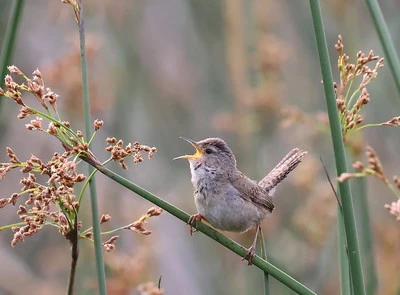
Appearance and Identification
The Marsh Wren is a small, lively bird with a compact, rounded body and a short, slightly curved bill. It has warm brown upperparts, a pale buff underside, and a striking white eyebrow stripe that contrasts with its dark cap. The back is heavily streaked with black and white, giving it a textured appearance. Its short tail is often held cocked upright, adding to its energetic look. At only about 5 inches in length, the Marsh Wren is easy to overlook—unless it’s singing—but its quick movements and perky posture help birders spot it among the reeds.
Habitat and Range in Florida
In Florida, the Marsh Wren is primarily a winter resident, although a small number may breed in the far north of the state. It favours dense wetland habitats, especially freshwater and brackish marshes filled with cattails, bulrushes, and sedges. These wrens are especially common in coastal estuaries and inland marshes with standing water and tall vegetation. Birders can often find them darting through reed beds or clinging sideways to stems just above the waterline. Patience is key—they are often more easily heard than seen.
Diet and Foraging Behaviour
Marsh Wrens feed almost exclusively on insects and other invertebrates, including beetles, spiders, ants, and fly larvae. They forage by climbing and hopping through vertical stems, probing leaf bases, and pecking around mud or shallow water. Their agility in dense vegetation is impressive, allowing them to reach crevices and spots that other birds avoid. Foraging usually occurs low to the water, and they may also hunt along floating mats of vegetation. Unlike many songbirds, Marsh Wrens rarely, if ever, visit feeders.
Vocalisations and Song
The Marsh Wren has a distinct, mechanical-sounding song—a rapid, chattering series of buzzy notes that resemble the rhythmic whirring of a sewing machine. Males are highly vocal, often singing from exposed perches during dawn and dusk. They also emit sharp “check” or “chuck” calls to express alarm or stake territory. Each male has a large song repertoire, and singing is a critical part of both courtship and territorial defence. Even in winter, they may occasionally burst into song on warm, sunny days.
Nesting and Breeding Habits
Although an uncommon breed in Florida, Marsh Wrens are known for their elaborate nesting behaviour in their core range. Males construct multiple “dummy” nests—oval-shaped structures made from reeds and grasses, often suspended in cattails or sedges above water. Only one nest is used for raising young; the rest may serve to attract a mate or deter predators. Females lay 4 to 6 eggs, incubating them for about two weeks. Both parents feed the chicks, which fledge in about 12–16 days after hatching.
Behaviour and Personality
These wrens are feisty and territorial, often aggressively defending their space from other wrens and marsh birds. They exhibit secretive behaviour, frequently staying out of view and weaving quickly through dense stems. Marsh Wrens are also known to destroy the eggs or nests of nearby birds, including their own species—a rare but well-documented behaviour in highly competitive marsh environments. Despite their small size, they’re full of personality and can be quite vocal and bold within their territory.
Conservation and Interesting Facts
Marsh Wrens are fairly common and widely distributed, but their dependence on healthy wetland ecosystems makes them vulnerable to habitat destruction, water pollution, and climate-related impacts. Restoration of wetlands and preservation of marsh buffers are critical to their continued success. Interestingly, they are among the few songbirds that build multiple nests in a season and possess one of the largest song repertoires relative to their size—some males sing more than 100 different variations. Their behaviour, song, and nesting habits make them a fascinating subject for both casual observers and ornithologists.
9. Field Sparrow (Spizella pusilla)
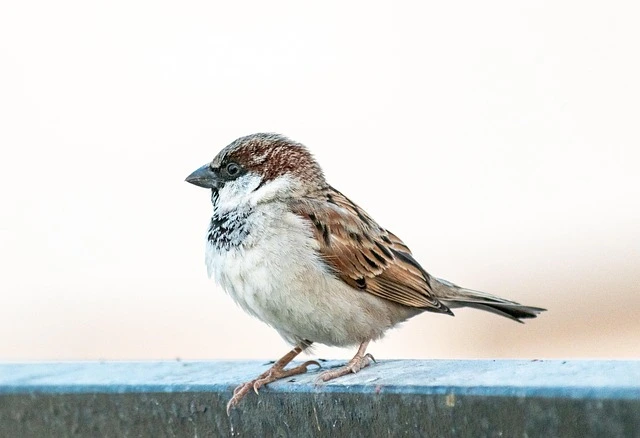
Appearance and Identification
The Field Sparrow is a small, gentle-looking bird with soft, earthy tones. It features a plain, grayish face, a subtle rusty crown, and a distinctive pink bill that sets it apart from other sparrows. Its upperparts are warm brown with fine streaks, while the underparts are clean and unmarked, fading to a light buff on the sides. Its tail is long and narrow, often slightly notched at the tip. At about 5 inches long, this sparrow’s delicate features and lack of bold markings give it an understated but graceful appearance. It has a quiet charm that makes it a favourite among birdwatchers.
Habitat and Range in Florida
In Florida, the Field Sparrow is a scarce winter resident, most commonly found in the northern and central parts of the state. It favours open country with scattered shrubs, such as old fields, overgrown pastures, pine flatwoods, and grassy clearings with brushy edges. They are less likely to be found in urban areas but may visit semi-rural properties with sufficient natural cover. Birders searching for Field Sparrows in Florida should look closely in areas with dry, open ground and clumps of low vegetation, especially in the morning when foraging is most active.
Diet and Foraging Behaviour
Field Sparrows feed mostly on grass seeds during the winter months. They forage quietly on the ground, often hopping slowly through grassy areas and picking seeds from the soil surface or low vegetation. Insects, including caterpillars and small beetles, make up a larger portion of their diet during the breeding season, though they’re less important in Florida’s mild winters. This species is generally shy and unobtrusive while feeding and rarely ventures into open areas unless cover is nearby.
Vocalisations and Song
The Field Sparrow’s song is a series of sweet, clear whistles that accelerate in tempo, often compared to the sound of a bouncing ball that speeds up before stopping. It’s a lovely and recognisable melody, heard most often on breeding grounds. Their call note is a thin, high “seep” or “tsee,” used frequently for communication between mates or among nearby individuals. While they don’t sing as much in winter, these soft call notes can still help birders locate them in Florida’s brushy fields.
Nesting and Breeding Habits
Field Sparrows do not typically breed in Florida, although they nest widely across the central and eastern U.S. In breeding habitats, they place their nests low to the ground, usually in clumps of grass, blackberry brambles, or small shrubs. The female constructs the nest and lays 3 to 5 speckled eggs. Incubation lasts around 10 to 12 days, and the chicks fledge in another 8 to 10 days. Pairs often raise two or even three broods during a single season in their breeding range.
Behaviour and Personality
Field Sparrows are calm and unobtrusive. They prefer solitude or the company of a mate rather than joining large winter flocks. Their movements are measured and careful, often staying low and moving through brushy cover rather than flying high or far. They are non-aggressive and tend to vanish quietly if disturbed. For patient birders, their subtle behaviour and delicate movements provide a rewarding viewing experience, especially when spotted among dry grasslands or overgrown clearings.
Conservation and Interesting Facts
Though still relatively common, Field Sparrow populations have declined in recent decades due to the loss of fallow fields and early-successional habitats caused by urbanisation and intensive agriculture. Conservation of old-field ecosystems and rotational land management are important to their survival. One unique trait is their tendency to sing throughout the day during the breeding season—even in the midday heat when most songbirds are silent. Their sweet, bouncing song and soft colours make them a quiet jewel of North America’s grassland bird community.
10. Sedge Wren (Cistothorus stellaris)
Appearance and Identification
The Sedge Wren is a tiny, cryptic bird with finely streaked brown upperparts, pale underparts, and a faint pale eyebrow stripe. Its short tail is often held upright, and its bill is short and slightly curved. Unlike the bolder Carolina Wren, the Sedge Wren has a softer, more subdued appearance, which blends perfectly into grassy marshes. It measures around 4.5 inches in length and can be challenging to spot due to its excellent camouflage.
Habitat and Range in Florida
This species is primarily a winter resident in Florida, favouring wet meadows, prairie marshes, and grassy wetlands. It prefers drier areas of marshes compared to the Marsh Wren and is often found in stands of sedge, rushes, or tall grasses. During the colder months, they become temporary residents across much of Florida’s wetland preserves and wildlife refuges.
Diet and Foraging Behaviour
Sedge Wrens feed on small insects and spiders, foraging low in dense vegetation. They move methodically through grass clumps, gleaning prey from stems and the ground. They are rarely seen in open view, often vanishing into thick cover at the slightest disturbance. Their feeding style is quiet and patient, often going unnoticed by casual observers.
Vocalisations and Song
The male’s song is a dry, mechanical chatter followed by short trills, unlike the melodic calls of many other wrens. These songs are used for territory defence and attracting mates. Though not as loud or varied as a Carolina Wren’s song, the Sedge Wren’s voice is distinctive and helpful for identification in dense habitat.
Nesting and Breeding Habits
Sedge Wrens do not typically breed in Florida. In their northern breeding range, males construct multiple dome-shaped nests using grasses and sedges, often suspended in vegetation. Only one of these structures is used for actual nesting. Females lay 5–8 eggs and handle most of the incubation and chick-rearing responsibilities.
Behaviour and Personality
Shy and elusive, Sedge Wrens are among the most difficult small birds to observe in Florida. They prefer solitude and blend seamlessly with their surroundings. When startled, they may freeze or drop silently into the grass rather than fly. Their behaviour is cautious and secretive, making patience essential for any birder hoping to observe one.
Conservation and Interesting Facts
Sedge Wren populations are stable but can be vulnerable to habitat loss and changes in wetland management. Their nomadic and unpredictable breeding habits make population monitoring difficult. They are one of the few North American songbirds to construct several dummy nests—a unique behaviour that continues to puzzle ornithologists.
Conclusion
While they may not dazzle with neon colours, Florida’s small brown birds are full of character, complexity, and ecological value. From the chatty Carolina Wren to the elusive Marsh Wren and the melodious Brown Thrasher, each species brings its own rhythm to the state’s natural soundtrack. Whether you’re exploring a coastal marsh, tending your garden, or walking through a pine flatwood, keep your ears and eyes open—because chances are, a small brown bird is watching you too.
By learning to identify and appreciate these understated beauties, you’ll gain a deeper connection with Florida’s wild spaces and the often-overlooked wonders fluttering right in your backyard.

Welcome to World Birds Life, where the wonder of birds takes center stage. My name is Lexi, and I’m passionate about helping you discover the beauty and joy that birds bring into our lives.

